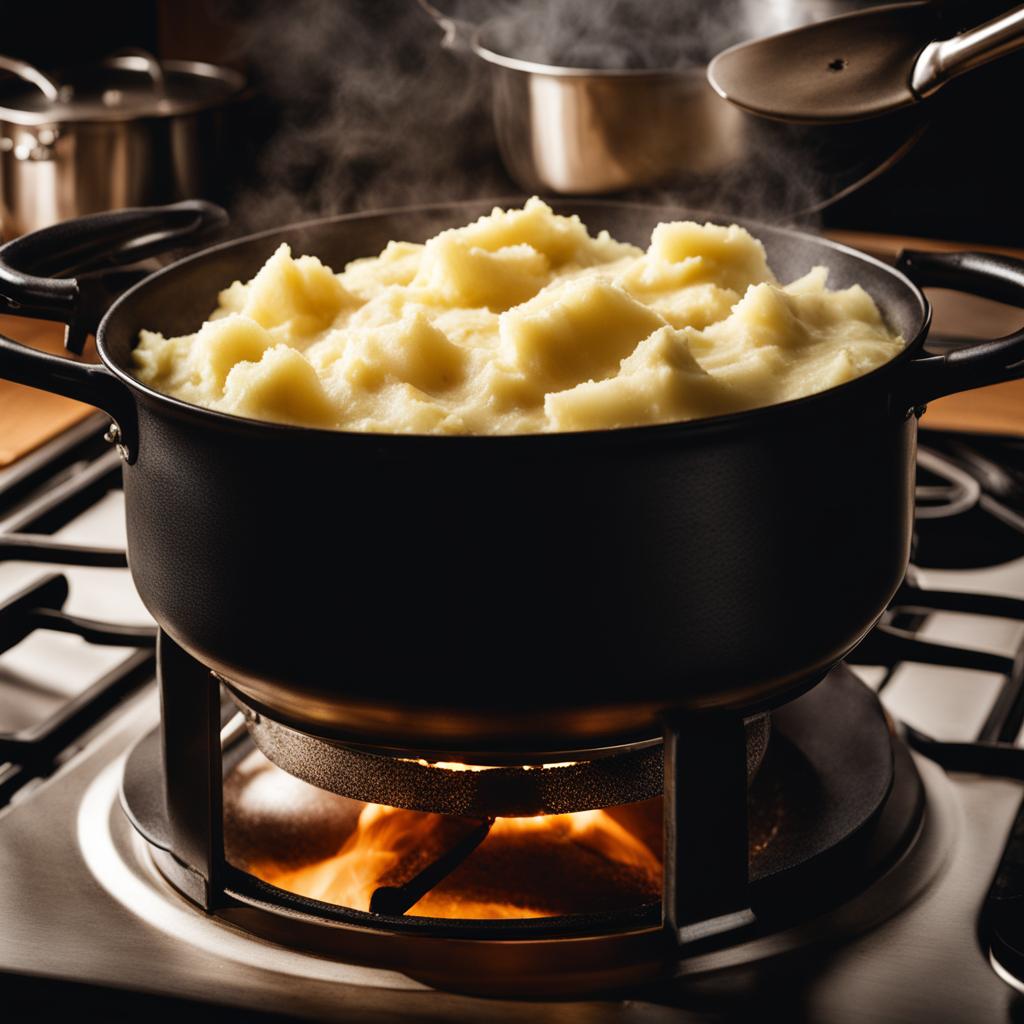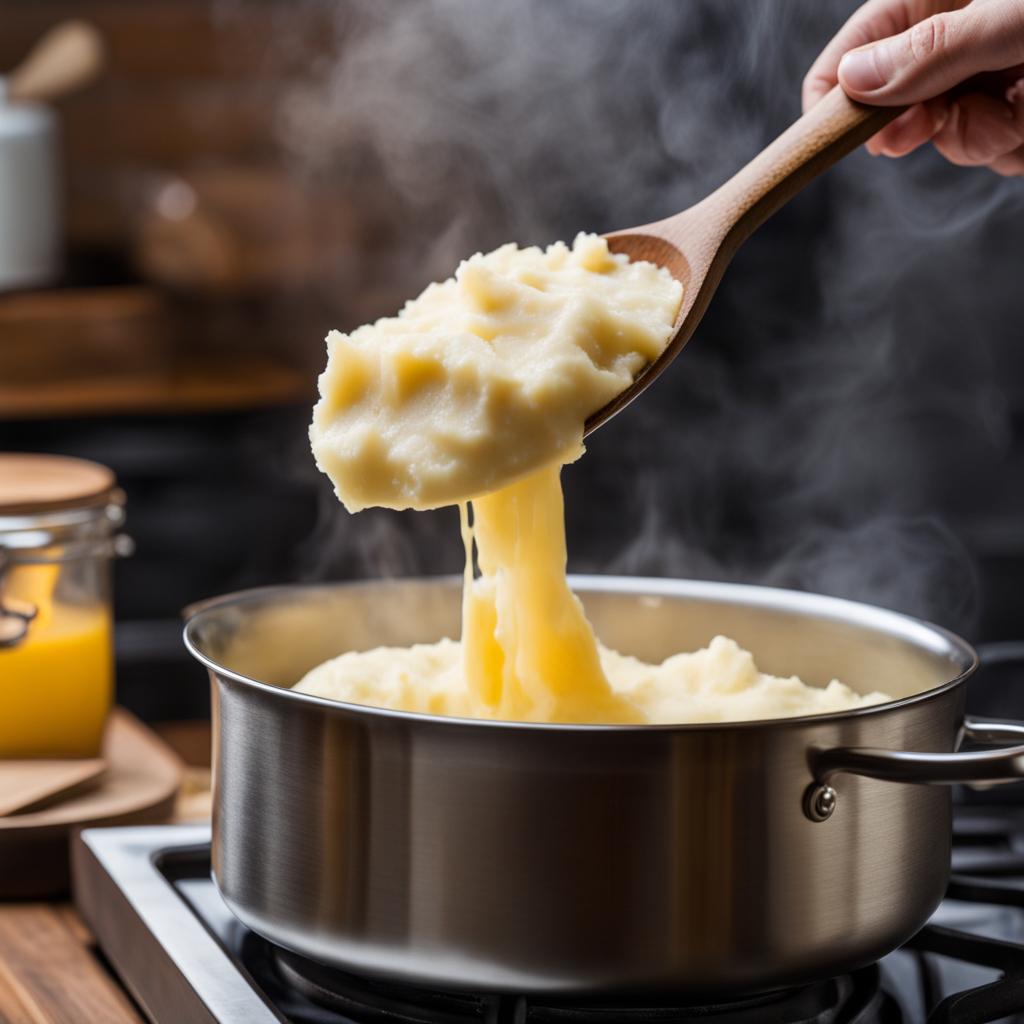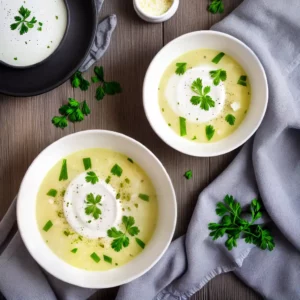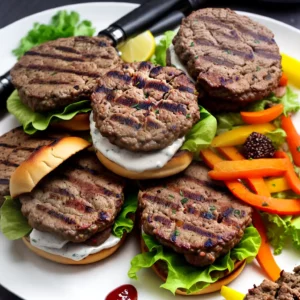Welcome to my step-by-step guide on how to thicken mashed potatoes! There’s nothing more disappointing than ending up with a bowl of soupy mashed potatoes. But fear not, I’ll show you some simple techniques to fix that and achieve the perfect consistency. Whether you prefer creamy or fluffy mashed potatoes, this guide will help you thicken them just the way you like!
Key Takeaways:
- Choose starchy potato varieties like russet or Yukon gold for better absorption of liquid.
- Mash the potatoes by hand and add warm liquid gradually to prevent them from becoming too runny.
- If your mashed potatoes are still watery, try methods like drying them out in the oven or folding in cooked potatoes.
- Instant potatoes, flour, cornstarch, or shredded raw potatoes can be used as quick and effective thickening agents.
- Experiment with cooking techniques like continued stovetop cooking or microwaving in short increments to achieve the desired thickness.
Basic Tips for Perfect Mashed Potatoes
When it comes to making mashed potatoes, achieving the perfect texture is essential. To avoid ending up with a bowl of watery mashed potatoes, there are a few basic tips that can help you create the creamy and fluffy dish you desire.
Choose the Right Potatoes
- Start with starchy varieties like russet or Yukon gold potatoes, as they have a higher starch content and absorb more liquid during cooking.
- Avoid waxy potatoes such as red or new potatoes, as they contain less starch and can result in a gummy texture.
Cooking Techniques Matter
- Begin by peeling and cutting the potatoes into evenly sized chunks before cooking.
- Place the potatoes in a pot of cold, salted water. Starting with cold water ensures even cooking and prevents the outer layer from becoming mushy while the center remains undercooked.
- Bring the water to a boil and cook the potatoes until they are fork-tender. Cooking times will vary depending on the size of the potato chunks.
- Drain the cooked potatoes and return them to the pot. Let them sit for a minute or two to dry out any excess moisture before mashing.
Mash with Care
- Using a potato masher or a fork, begin mashing the potatoes gently. Avoid overworking them, as this can release excess starch and result in a gluey texture.
- Gradually add warm liquid, such as melted butter or warm milk, to the mashed potatoes. Adding it gradually allows you to control the consistency and prevent them from becoming too runny.
- Continue mashing and mixing until you achieve the desired texture. If you prefer smoother mashed potatoes, use a hand mixer or stand mixer on low speed, but be cautious not to overmix.
By following these basic tips and techniques, you can ensure your mashed potatoes turn out perfectly creamy and delicious every time. Experiment with different potato varieties and cooking methods to find your favorite combination. Remember, practice makes perfect!
How to Fix Watery Mashed Potatoes
If your mashed potatoes turn out too runny despite following the basic tips, there are several techniques you can try to thicken them. One method is to transfer them to a shallow container and dry them out in the oven. Another option is to cook more potatoes separately and then fold them into the watery batch. You can also use dehydrated mashed potato flakes or whisk in small amounts of cornstarch, tapioca starch, or potato starch to thicken the potatoes to your liking.
When using the oven method, preheat your oven to 350°F (175°C). Spread the mashed potatoes evenly in a shallow baking dish and bake for about 20 to 30 minutes, or until the excess moisture evaporates and the potatoes become thicker. Keep an eye on them to prevent them from drying out too much.
If you prefer a more natural approach, you can cook additional potatoes separately and mash them before folding them into the watery mashed potatoes. This will add more texture and thickness to the mixture. Alternatively, you can use dehydrated mashed potato flakes according to the package instructions, gradually incorporating them into the mashed potatoes until you achieve the desired consistency.
Thickening Agents Options:
- Cornstarch
- Tapioca Starch
- Potato Starch
Another method is to whisk in small amounts of thickening agents like cornstarch, tapioca starch, or potato starch. Start by mixing a tablespoon of the chosen thickening agent with a tablespoon of cold water to form a slurry. Gradually whisk the slurry into the watery mashed potatoes and continue cooking over low heat until the mixture thickens.
Table:
| Thickening Agent | Amount |
|---|---|
| Cornstarch | 1 tablespoon |
| Tapioca Starch | 1 tablespoon |
| Potato Starch | 1 tablespoon |
By following these methods and experimenting with different techniques, you can easily fix watery mashed potatoes and achieve the perfect consistency. Whether you choose to use the oven method, add cooked potatoes, incorporate dehydrated mashed potato flakes, or whisk in thickening agents, you’ll be able to salvage your mashed potatoes and serve them with confidence.
Thicken Mashed Potatoes with Instant Potatoes
When it comes to quickly thickening mashed potatoes, instant potatoes are a convenient and effective option. Using instant dehydrated potatoes allows you to easily adjust the consistency of your mashed potatoes to your liking. Simply mix in the instant potatoes a tablespoon at a time until you achieve the desired thickness.
While instant mashed potatoes may not have the same flavor and texture as freshly made mashed potatoes, they can still be a useful solution for thickening purposes. The instant potatoes act as an absorbent, soaking up the excess liquid in your mashed potatoes and creating a thicker consistency.
To use instant potatoes, start by preparing them according to the package instructions. Once the instant potatoes are ready, add them to your soupy mashed potatoes a little at a time, stirring well after each addition. Keep adding instant potatoes until you achieve the desired thickness. Remember to taste and adjust the seasoning of your mashed potatoes as needed.
Keep in mind that the amount of instant potatoes needed may vary depending on the quantity of mashed potatoes you have and the level of thinness. It’s always best to add the instant potatoes gradually, allowing you to control the thickness and avoid over-thickening your mashed potatoes.
Thickening Mashed Potatoes with Flour or Cornstarch
When it comes to thickening mashed potatoes, flour and cornstarch are two common go-to options. These pantry staples can help you achieve the desired consistency while adding a touch of thickness to your creamy creation.
To thicken your mashed potatoes with flour or cornstarch, follow these simple steps:
- Prepare your potatoes: Start by boiling, draining, and mashing your potatoes as usual. Make sure they are well-cooked and free of lumps.
- Add the thickening agent: Gradually sprinkle in small amounts of flour or cornstarch, about a tablespoon at a time, while stirring continuously. This will help prevent clumps from forming.
- Monitor the consistency: Keep an eye on the texture of your mashed potatoes as you add the thickening agent. Stop adding the flour or cornstarch once you reach the desired thickness. Remember, a little goes a long way, so be cautious not to overdo it and make the potatoes gluey.
By incorporating flour or cornstarch into your mashed potatoes, you can transform a watery mixture into a velvety delight. These thickening agents offer versatility and are readily available in most kitchens, making them convenient options for rescuing your runny mashed potatoes.
Comparison of Flour and Cornstarch for Thickening Mashed Potatoes
| Flour | Cornstarch |
|---|---|
| Commonly used in cooking and baking | Often used as a thickening agent in recipes |
| Has a neutral flavor | Has a neutral flavor |
| Requires more quantity to achieve the same thickness | Requires less quantity to achieve the same thickness |
| May result in a slightly grainy texture | Yields a smoother texture |
| Can alter the final color of the mashed potatoes | Does not affect the color of the mashed potatoes |
When choosing between flour and cornstarch, consider the desired texture, taste, and appearance of your mashed potatoes. While flour requires a larger quantity to achieve the same thickness, it can introduce a slightly grainy texture. On the other hand, cornstarch requires less quantity and creates a smoother consistency. Additionally, flour may alter the color of the mashed potatoes, while cornstarch does not affect the color.
Experimenting with different thickening agents can help you find the perfect balance and create mashed potatoes that are not only thick, but also flavorful and visually appealing.
Cooking the Mash to Thicken
When it comes to fixing runny mashed potatoes, cooking them further can be an effective method for thickening. By continuing to cook the mash on the stove or in the oven without the lid, the heat will draw out the excess moisture, resulting in a denser finished product. However, it is crucial to monitor the cooking process closely to prevent the potatoes from becoming overdone and gummy.
To cook the mash on the stovetop, place the pot over medium-low heat and stir occasionally. This will allow the excess moisture to evaporate gradually while maintaining a consistent heat. Avoid stirring constantly, as this can result in a gummy texture.
If you prefer using the oven, transfer the mashed potatoes to an oven-safe dish and bake at a moderate temperature, around 325°F (163°C). The uncovered dish will help remove the excess moisture and thicken the potatoes. It’s important to check on them periodically and adjust the cooking time as needed to achieve the desired consistency.

Expert Tip:
When cooking the mashed potatoes to thicken, it’s essential to strike the right balance between removing excess moisture and preserving the creamy texture. Make sure to keep an eye on them and avoid overcooking, as this can lead to dry and lumpy potatoes.
Shredded Potato Method for Thickening
If you’re looking for a unique and effective way to thicken your mashed potatoes, the shredded potato method is worth considering. This technique not only adds thickness to your potatoes but also introduces an interesting texture that can elevate your dish.
To utilize this method, start by shredding one to two raw potatoes into a skillet. Make sure to cover the shredded potatoes with enough water and bring the mixture to a boil. As the potatoes soften, drain the water and mash the potato shreds. Finally, mix them into your watery mashed potatoes to achieve the desired thickness.
This method works well because the shredded potatoes release starch as they cook, helping to thicken the overall consistency of the dish. The added texture from the potato shreds also provides a delightful contrast to the smoothness of the mashed potatoes.
Give the shredded potato method a try if you’re looking for a creative way to thicken your mashed potatoes. It’s an easy and straightforward technique that can transform your runny mashed potatoes into a thicker and more satisfying dish.
| Pros | Cons |
|---|---|
| Provides a unique texture | Requires additional preparation |
| Helps thicken watery mashed potatoes | May alter the flavor slightly |
| Easy to execute | Not suitable for those who prefer smooth mashed potatoes |
Tips for Choosing the Right Thickening Agents
When it comes to thickening mashed potatoes, there are several options to choose from. The choice of thickening agent can have a significant impact on the texture and flavor of your mashed potatoes. Here are some tips to help you choose the right thickening agent:
1. Consider the desired consistency:
Different thickening agents have different thickening powers. Some agents, like flour and cornstarch, are more effective at thickening than others. Consider the consistency you want to achieve and choose an agent accordingly.
2. Think about the flavor profile:
Thickening agents can add their own flavor to your mashed potatoes. For example, adding powdered milk can give the potatoes a creamy and rich flavor, while parmesan cheese can add a savory and cheesy taste. Consider how the flavor of the thickening agent will complement the overall flavor of your mashed potatoes.
3. Consider dietary restrictions:
If you or your guests have any dietary restrictions, such as gluten intolerance, it’s important to choose a thickening agent that is suitable. There are gluten-free options available, such as potato starch, arrowroot, and tapioca. Make sure to read the labels and choose an agent that meets your dietary needs.
4. Experiment and find your favorite:
The best way to find the right thickening agent for your mashed potatoes is through experimentation. Try different agents and combinations to see which one gives you the desired thickness and flavor. You may also find that certain agents work better for specific recipes or personal preferences.
By considering the desired consistency, flavor profile, dietary restrictions, and experimenting with different options, you can choose the right thickening agent for your mashed potatoes. Remember, everyone has their own preferences, so don’t be afraid to get creative and find the combination that works best for you.
Heat Method for Thickening Mashed Potatoes
Mashed potatoes too runny? Don’t worry, I’ve got you covered! One effective method to thicken your mashed potatoes is by using heat. This technique involves gently cooking the potatoes on the stove to evaporate the excess moisture, resulting in a thicker consistency.
To use the heat method, start by placing your mashed potatoes in a large pot over medium-low heat. Make sure to leave the pot uncovered to allow the moisture to escape. Stir the potatoes occasionally to ensure even heat distribution.
As you heat the mashed potatoes, you’ll notice that the excess moisture begins to evaporate, gradually thickening the mixture. Be patient, as this process can take some time. Keep stirring occasionally until you achieve your desired consistency.
Remember, it’s important not to stir constantly, as this can result in a gummy texture. Instead, stir occasionally and let the heat do its magic. Once your mashed potatoes have thickened to your liking, remove them from the heat and serve them up for a deliciously thick and creamy side dish.

Benefits of Using the Heat Method
- The heat method is a natural way to thicken mashed potatoes without relying on additional ingredients.
- It allows the excess moisture to evaporate, resulting in a denser and creamier texture.
- The heat method is simple and easy to implement, requiring only a stove and a large pot.
Microwave Method for Thickening Mashed Potatoes
When it comes to quickly thickening mashed potatoes, the microwave method is a convenient option. This technique allows you to control the consistency of your potatoes with precision. Here’s how to do it:
- Start by placing your mashed potatoes in a microwave-safe bowl. Make sure the bowl is large enough to accommodate the potatoes without any spillover.
- Set the microwave to a medium-high power setting. This will ensure that the potatoes heat evenly without becoming overcooked.
- Heat the mashed potatoes in the microwave for 1-2 minutes, depending on the desired thickness. After each interval, remove the bowl and check the consistency. If the potatoes are not thick enough, continue microwaving in short increments until you reach the desired thickness.
- Remember to stir the mashed potatoes well after each interval to distribute the heat and promote even thickening.
The microwave method is a quick and efficient way to thicken your mashed potatoes without the need for additional ingredients or cooking methods. It’s important to keep a close eye on the potatoes as they heat in the microwave to prevent them from overcooking or drying out.
“The microwave method is a game-changer when it comes to thickening mashed potatoes in a pinch. It’s easy, fast, and gives you full control over the consistency of your potatoes.” – Chef Emily
Baking Method for Thickening Mashed Potatoes
When it comes to thickening mashed potatoes, the baking method can be a convenient and effective technique. By baking the mashed potatoes in an uncovered, oven-safe casserole dish, excess moisture can be removed, resulting in a thicker and more desirable consistency. Here’s how to use the baking method:
- Preheat your oven to 325°F (163°C).
- Transfer the mashed potatoes to an oven-safe casserole dish.
- Spread the mashed potatoes evenly in the dish.
- Place the casserole dish in the preheated oven and bake for 10-15 minutes.
- Keep an eye on the mashed potatoes while baking to prevent them from drying out or becoming too crispy.
- Once the desired thickness is achieved, remove the dish from the oven and serve the deliciously thickened mashed potatoes.
The baking method can be a great alternative if your stovetop is occupied or if you prefer using the oven. It allows the excess moisture to evaporate, resulting in mashed potatoes with a denser texture. However, be cautious not to overbake the potatoes, as they can become too dry. Monitor the baking time closely to ensure the desired consistency is reached.
Table: Baking Method for Thickening Mashed Potatoes
| Method | Instructions |
|---|---|
| 1. Preheat oven | 325°F (163°C) |
| 2. Transfer mashed potatoes | To an oven-safe casserole dish |
| 3. Spread mashed potatoes | Evenly in the dish |
| 4. Bake | 10-15 minutes |
| 5. Monitor | Prevent drying out or becoming too crispy |
| 6. Remove and serve | Once desired thickness is achieved |
Using the baking method can help you achieve the perfect consistency for your mashed potatoes. Whether you’re looking to fix soupy mashed potatoes or simply prefer a thicker texture, give the baking method a try and enjoy a delicious side dish!
Combining Methods for Thicker Mashed Potatoes
When it comes to achieving the perfect thickness in mashed potatoes, combining methods can be an effective approach. By utilizing multiple techniques, you can tailor the consistency to your liking and ensure a delicious result. Here are some ways to combine methods to thicken mashed potatoes:
1. Shredding Method and Heat Method:
The shredding method is a great way to add texture to your mashed potatoes. Start by shredding 1-2 raw potatoes into a skillet and add enough water to cover them. Boil the mixture until the potatoes are soft, then drain the water and mash the potato shreds. Next, utilize the heat method by placing the mashed potatoes in a large, uncovered pot over medium-low heat. Stir occasionally until excess moisture evaporates and the desired thickness is achieved.
2. Thickening Agents and Cooking Methods:
If your mashed potatoes are still too thin after using the basic tips, consider adding thickening agents like flour, cornstarch, or dehydrated potato flakes. Gradually stir in these ingredients, a tablespoon at a time, until the desired thickness is reached. Additionally, you can cook the mashed potatoes using the heat method or bake them in an uncovered, oven-safe casserole dish to remove excess moisture and thicken them further.
3. Layered Approach:
For severely watery mashed potatoes, a layered approach can be effective. Begin by using the shredding method to add more texture, then incorporate thickening agents and cooking methods as needed until you achieve the desired consistency. This method allows you to gradually build up the thickness while still maintaining the desired texture and flavor.
Remember, experimentation is key when combining methods, as different potatoes and personal preferences may require adjustments. By taking a multidimensional approach, you can confidently thicken your mashed potatoes and delight your taste buds with the perfect texture.
Choosing the Right Potatoes for Creamy Mashed Potatoes
When it comes to achieving creamy mashed potatoes, the choice of potato variety is key. Not all potatoes are created equal when it comes to mashing. Starchy varieties like Yukon gold or russet potatoes are highly recommended for their fluffy texture when cooked. These potatoes have a higher starch content and lower moisture levels, resulting in a velvety smooth consistency that is perfect for creamy mashed potatoes.
On the other hand, waxy potatoes, such as red or new potatoes, are less ideal for mashing. These potatoes have a lower starch content and higher moisture levels, which can lead to a gummy texture when mashed. While they may work for other potato dishes, they are not the best choice for achieving creamy mashed potatoes.
So, the next time you’re making mashed potatoes, reach for the starchy varieties like Yukon gold or russet potatoes. Their fluffy texture and ability to absorb more liquid will ensure that your mashed potatoes turn out creamy, smooth, and absolutely delicious.
Table: A Comparison of Potato Varieties for Mashed Potatoes
| Potato Variety | Starch Content | Moisture Level | Texture |
|---|---|---|---|
| Yukon Gold | High | Low | Creamy and Fluffy |
| Russet | High | Low | Creamy and Fluffy |
| Red Potatoes | Low | High | Gummy and Waxy |
| New Potatoes | Low | High | Gummy and Waxy |
Table: A comparison of potato varieties for mashed potatoes.
Avoiding Common Mistakes for Thickening Mashed Potatoes
When it comes to thickening mashed potatoes, there are a few common mistakes that can easily be avoided. These mistakes can result in gluey or watery mashed potatoes, ruining your efforts to achieve the perfect consistency. To help you avoid these pitfalls, I’ve compiled a list of the most common mistakes to watch out for.
Using Mixers, Food Processors, or Blenders
One of the biggest mistakes when making mashed potatoes is using mixers, food processors, or blenders to mash them. These appliances can overwork the potatoes, releasing excess starch and creating a gummy texture. To achieve fluffy and light mashed potatoes, it’s best to mash them by hand using a potato masher or a fork.
Overworking the Potatoes
Overworking the potatoes is another mistake that can lead to a gummy texture. Once the potatoes are cooked and drained, it’s important to mash them just until they reach a smooth consistency. Avoid the temptation to keep mashing or mixing them, as this can result in an undesirable texture.
Using Too Much Liquid or Overcooking the Potatoes
Using excessive amounts of liquid, such as milk or cream, can make your mashed potatoes too runny. It’s important to add warm liquid gradually, ensuring that the potatoes absorb it without becoming too watery. Additionally, overcooking the potatoes can also contribute to a watery consistency. Cook the potatoes until they are tender but not overly soft, as this will help maintain a thicker texture.
| Mistake | Effect | Solution |
|---|---|---|
| Using mixers, food processors, or blenders | Gummy texture | Mash by hand using a potato masher or fork |
| Overworking the potatoes | Gummy texture | Mash just until smooth, avoiding excessive mixing |
| Using too much liquid or overcooking the potatoes | Watery consistency | Add warm liquid gradually and cook until tender but not overly soft |
Reinventing Leftover Mashed Potatoes
When you find yourself with leftover mashed potatoes, don’t let them go to waste. There are many creative and delicious ways to transform them into new dishes that your family will love. By reinventing leftovers, you can save time and money while reducing food waste. Here are some ideas to inspire you:
Fried Mashed Potato Balls
One fun way to repurpose mashed potatoes is to turn them into crispy fried potato balls. Simply form the leftover mashed potatoes into small, bite-sized balls. You can add shredded cheese, herbs, or cooked bacon for extra flavor. Roll the balls in breadcrumbs and deep-fry them until golden and crispy. Serve them as a savory appetizer or as a side dish with your favorite dipping sauce.
Crispy Mashed Potato Cakes
Another tasty option is to transform your mashed potatoes into crispy cakes. Mix the leftover mashed potatoes with some breadcrumbs, grated cheese, and chopped herbs. Shape the mixture into patties and pan-fry them until they develop a golden crust. These potato cakes are a great alternative to regular hash browns and can be served for breakfast, brunch, or as a side dish with roasted meats.
Add Fresh Herbs and Flavors
If you prefer to enjoy the leftover mashed potatoes as they are, you can elevate their flavor by adding fresh herbs and other complementary ingredients. Finely chop fresh herbs like parsley, chives, or rosemary, and mix them into the mashed potatoes. You can also add a drizzle of brown butter or top the potatoes with caramelized onions for extra depth of flavor and richness.
| Leftover Mashed Potato Recipes | Ingredients | Instructions |
|---|---|---|
| Fried Mashed Potato Balls | – Leftover mashed potatoes – Shredded cheese – Herbs or cooked bacon (optional) – Breadcrumbs |
|
| Crispy Mashed Potato Cakes | – Leftover mashed potatoes – Breadcrumbs – Grated cheese – Chopped herbs |
|
By getting creative with your leftovers, you can enjoy mashed potatoes in new and exciting ways. Whether you choose to turn them into crispy fried balls or transform them into savory cakes, reinventing leftovers is a practical and delicious way to make the most of your leftover mashed potatoes.
Conclusion
Thickening mashed potatoes doesn’t have to be a daunting task. With the help of these tips and techniques, you can easily fix soupy mashed potatoes and achieve the perfect texture. Whether you prefer using instant potatoes, flour, cornstarch, or a combination of methods, there is a solution to suit your needs.
Experimenting with different thickening agents and cooking methods will allow you to find your preferred approach. Remember to start with the right kind of potatoes, cook them properly, and add warm liquid gradually to avoid ending up with mashed potatoes that are too thin.
So the next time you find yourself with watery mashed potatoes, don’t worry. You now have a step-by-step guide and a variety of techniques to thicken them to your liking. Put your newfound knowledge to the test and enjoy perfectly thick and creamy mashed potatoes every time!
FAQ
How can I thicken mashed potatoes that are too runny?
There are several methods you can try. You can dry them out in the oven, add cooked potatoes to thicken, use dehydrated mashed potato flakes, or whisk in small amounts of cornstarch, tapioca starch, or potato starch.
Can I use instant mashed potatoes to thicken runny mashed potatoes?
Yes, instant mashed potatoes can be used to thicken mashed potatoes. Simply mix them in a tablespoon at a time until you achieve the desired consistency.
What are some other thickening agents I can use for mashed potatoes?
You can use flour, cornstarch, powdered milk, potato starch, arrowroot, tapioca, or parmesan cheese as thickening agents for mashed potatoes.
How can I thicken mashed potatoes using the heat method?
You can thicken mashed potatoes by continuing to cook them on the stove or in the oven without the lid. The heat will draw out the excess moisture, resulting in a denser finished product.
Can shredded raw potatoes be used to thicken mashed potatoes?
Yes, you can shred raw potatoes, boil them, and then mix them into the watery mashed potatoes to thicken them.
What are some common mistakes to avoid when thickening mashed potatoes?
Avoid using mixers, food processors, or blenders, as they can make the potatoes gluey. Overworking the potatoes can also release excess starch and result in a gummy texture. Additionally, using too much liquid or overcooking the potatoes can make them watery.
What can I do with leftover mashed potatoes?
You can use leftover mashed potatoes to make fried mashed potato balls or crispy mashed potato cakes. Adding fresh herbs, brown butter, or caramelized onions can also elevate the flavor of leftover mashed potatoes.
Source Links
- https://www.southernliving.com/food/veggies/potatoes/how-to-thicken-mashed-potatoes
- https://www.simplyrecipes.com/how-to-thicken-mashed-potatoes-7480961
- https://www.wikihow.com/Thicken-Mashed-Potatoes
Related Recipes:
 How to Thicken Pasta Sauce: Techniques and Tips
How to Thicken Pasta Sauce: Techniques and Tips
 How to Keep Mashed Potatoes Warm for Dinner Parties
How to Keep Mashed Potatoes Warm for Dinner Parties
 How to Thicken Beef Stew: Tips for a Perfect Consistency
How to Thicken Beef Stew: Tips for a Perfect Consistency
 How to Reheat Mashed Potatoes: Keep Them Creamy
How to Reheat Mashed Potatoes: Keep Them Creamy
 Mashed Potatoes: How Long Do They Last?
Mashed Potatoes: How Long Do They Last?
 How to Cook Air Fryer Potatoes? (Perfect Step-By-Step Guide)
How to Cook Air Fryer Potatoes? (Perfect Step-By-Step Guide)
 How to Tell if Potatoes Are Done: Cooking Tips
How to Tell if Potatoes Are Done: Cooking Tips
 How Many Potatoes in a Pound? (Perfect Measurement Conversion Guide)
How Many Potatoes in a Pound? (Perfect Measurement Conversion Guide)







